Fix email delivery issues for error code 5.1.10 in Office 365
Problems sending and receiving email messages can be frustrating. If you get a non-delivery report (NDR), also called a bounce message, for error code 550 5.1.10, this article can help you fix the problem and get your message sent.
 |  |
Why did I get this bounce message?
You received this bounce message with error code 5.1.10 for one of two reasons:
-
The email address you sent your message to doesn't exist or couldn't be found. Go to I got this bounce message. Help me fix it.
-
Someone else, typically a spammer, impersonated you by sending a message with your email address in the From box. This is called email spoofing. The email address it was sent to doesn't exist, and you got the bounce message for it. This type of bounce message is called backscatter and it can be ignored or deleted.
Backscatter itself is harmless, but if you're getting a lot of it, it's possible your computer or device is infected with spam-sending malware. Consider running an antimalware scan. Additionally, to help prevent spammers from impersonating you or others in your organization, ask your email admin to read this topic: Set up SPF in Office 365 to help prevent spoofing.
I got this bounce message. Help me fix it.
Verify that the recipient's email address is correct and then send your message again. If that doesn't solve the problem, get in touch with the recipient and ask them to check their forwarding rules and settings.
Make sure the recipient's email address is correct and then resend your message
-
Double-click the bounce message you received to open it.
-
From the Report tab, choose Send Again.

Note: If the original message you sent had an attachment larger than 10 MB, the Send Again option may not be available or may not work. Instead, open the original message from your Sent Items folder and resend it. For more information, see Resend an email message.
-
In the new copy of your message, select the recipient's email address in the To box and then press the Delete key.
-
Remove the recipient's address from the Auto-Complete list to help ensure that Outlook doesn't use an outdated email address. Follow these steps:
-
In the To box, start typing the recipient's email address until it appears in the Auto-Complete drop-down list as shown below. (If the Auto-Complete list doesn't pop up, or the recipient's address isn't listed, skip to step 5.)
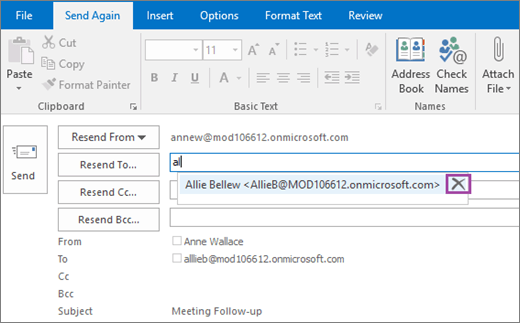
-
Use the Down Arrow key to select the recipient from the Auto-Complete drop-down list and then press the Delete key or click the delete icon
 to the right of the email address.
to the right of the email address.
-
-
In the To box, continue typing the entire recipient email address. Make sure you spell the address correctly.
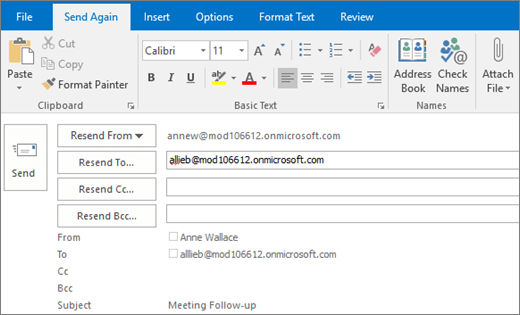
-
Click Send.
-
Select the bounce email message you received to open it.
-
In the message reading pane, just below the message header information, click To send this message again, click here.
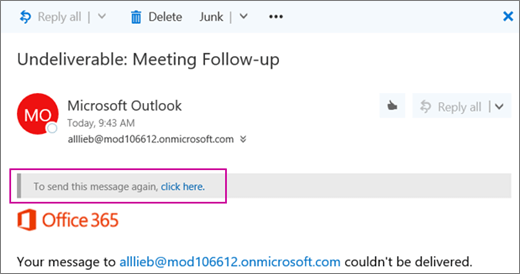
Note: If the original message you sent had an attachment larger than 10 MB, the option To send this message again won't be available. Instead, resend the original message from your Sent Items folder.
-
On the To line of the new copy of your message, click the delete icon
 to the right of the email address to delete the recipient's address.
to the right of the email address to delete the recipient's address.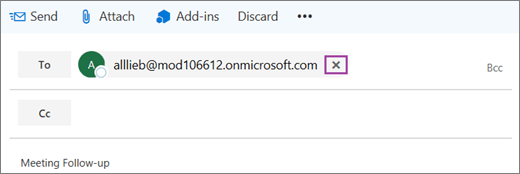
-
Remove the recipient's address from the Auto-Complete list to help ensure Outlook doesn't use an outdated email address. Follow these steps:
-
On the empty To line, start typing the recipient's name or email address until it appears in the Auto-Complete drop-down list.

-
Use the Down Arrow key to select the recipient from the Auto-Complete list, and then press the Delete key. Or, hover over the recipient's name and click the delete icon
 to the right of the email address.
to the right of the email address.
-
-
On the To line, continue typing the entire recipient email address. Make sure you spell the address correctly.
-
Click Send.
Ask the recipient to check for broken forwarding rules or settings
Contact the recipient by some other means (by phone, for example), and ask them to check for forwarding rules or settings that might be forwarding your message to an email address that doesn't exist or is broken. If they have forwarding set up, they should either change the email address that messages are forwarded to or they should disable the forwarding rule or setting.
Office 365 supports multiple ways to forward messages automatically. If the intended recipient of your message is using Office 365, ask them to review the Update, disable, or remove Inbox Rules forwarding and Disable account forwarding sections below. If the problem persists after performing these steps, ask the recipient to refer their email admin to the I'm an email admin. How can I fix this? section below.
Update, disable, or remove Inbox Rules forwarding-
In Office 365, sign in to your user account.
-
Click the gear icon in the top right corner to show the Settings pane.
-
Select Your app settings > Mail.
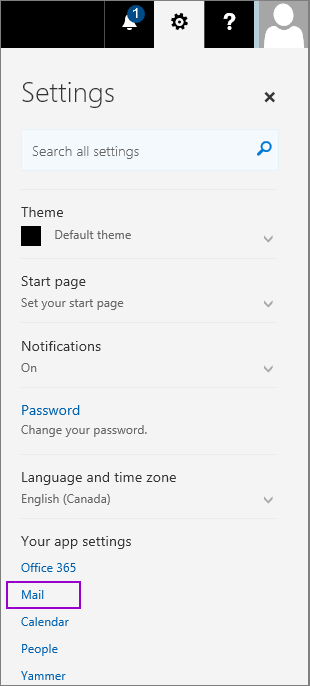
-
From the Options navigation pane on the left, select Mail > Automatic processing > Inbox and sweep rules.

-
Update, turn off, or delete any rules that may be forwarding the sender's message to a non-existent or broken email address.
-
Sign in to your Office 365 account, and from the same Options navigation as shown above, select Mail > Accounts > Forwarding.
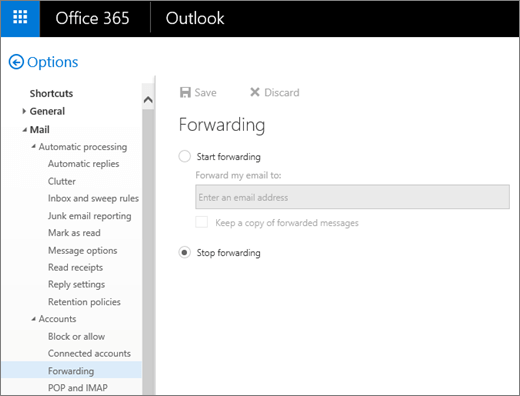
-
Select Stop forwarding and click Save to disable Account forwarding.
I'm an email admin. How can I fix this?
If the sender who got this bounce message can't fix the issue using the steps above, the problem might be that an email system on the receiving side isn't configured correctly. If you're the email admin for the recipient, try one or more of the following fixes and then ask the sender to resend the message:
Verify that the recipient exists and has an active license assigned
-
In the Office 365 admin center, choose Users to go to the Active users page.
-
In the Active users > Filters search field, type part of the recipient's name, and then press Enter to locate the recipient. If the recipient doesn't exist, then you must create a new mailbox or contact for this user. (For more information, see Add users individually or in bulk to Office 365 - Admin Help.) If the recipient does exist, make sure the recipient's User name matches the email address the sender used.

-
If the user's mailbox is hosted in Office 365, click the user's record to review their details and verify that they've been assigned a valid license for email (for example, an Office 365 Enterprise E5 license).

-
If the user's mailbox is hosted in Office 365, but no license has been assigned, select Edit and assign the user a license.

Fix or remove broken forwarding rules or settings
Office 365 provides the following features for users and email admins to forward messages to another email address:
-
Forwarding using Inbox rules (user)
-
Account forwarding (user and email admin)
-
Forwarding using Mail flow rules (email admin)
Follow the steps below to fix the recipient's broken mail forwarding rule or settings.
-
Forwarding using Inbox rules (user)
The recipient may have an Inbox rule that is forwarding messages to a problematic email address. Inbox rules are available only to the user (or someone with delegate access to their account). See Update, disable, or remove Inbox Rules forwarding for how the user, or their delegate, can change or remove a broken forwarding Inbox rule.
-
Account forwarding (user and email admin)
-
In the Office 365 admin center, choose Users.
-
In the Active users > Filters search field, type part of the recipient's name and then press Enter to locate the recipient. Click the user's record to view its details.
-
From the user's profile page, select Mail Settings > Email forwarding > Edit.
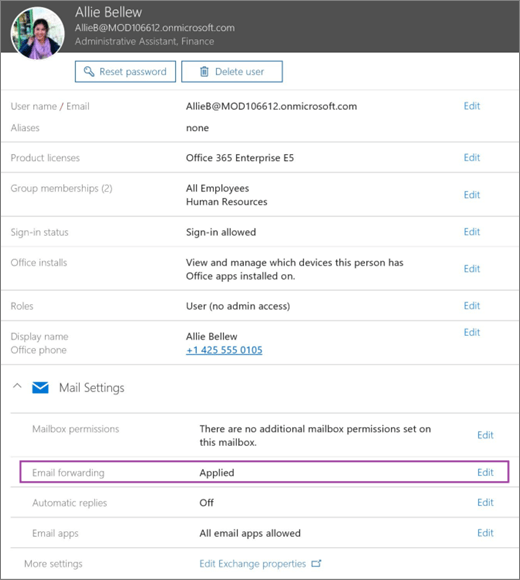
-
Turn off Email forwarding and select Save.
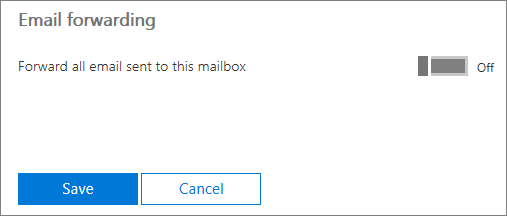
-
-
Forwarding using Mail flow rules (email admin)
Unlike Inbox rules which are associated with a user's mailbox, mail flow rules are organization-wide settings and can only be created and edited by email admins.
-
In the Office 365 Admin center, select Admin centers > Exchange.
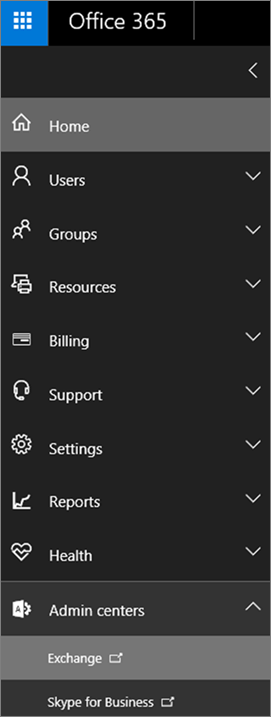
-
In the Exchange admin center, go to mail flow > rules.
-
Look for any Redirect rules that may be forwarding the sender's message to another address. An example is shown below.
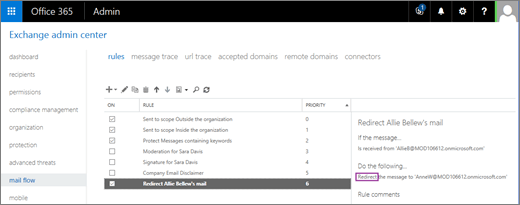
-
Update, turn off, or delete any suspect forwarding rules.
-
Update Accepted Domain settings
Caution: Message routing topologies and settings, especially for hybrid configurations, can be complex. Even if changing the Accepted Domain setting fixes the bounce message problem, it may not be right solution for your situation. In some cases, it may even cause other unanticipated problems. Please review Manage accepted domains in Exchange Online and then proceed with caution.
If you've set up a hybrid configuration (some mailboxes in the cloud and some mailboxes on-premises) and the Accepted Domain for your domain is set to Authoritative, Office 365 looks for the recipient only in your cloud directory. If the recipient is on-premises, and you haven't added the recipient to your cloud directory (either manually or via Directory Synchronization), the look-up fails, and the sender may receive this bounce message. If the Accepted Domain is set to Internal Relay, Office 365 first checks your cloud directory, and if the recipient isn't found there, it routes the message to your on-premises mail servers (assuming you've correctly set up a required mail flow connector to do so).
Warning: When setting Accepted Domain to Internal Relay, you must set up a corresponding Office 365 mail flow connector to your on-premises environment. Failing to do so will break mail flow to your on-premises mailboxes.
If you have a hybrid configuration with an Office 365 mail flow connector configured to route messages to your on-premises environment, and you believe that Internal Relay is the correct setting for your domain, change the Accepted Domain from Authoritative to Internal Relay by doing the following:
-
From the Exchange admin center, choose mail flow > accepted domains and select the recipient's domain.
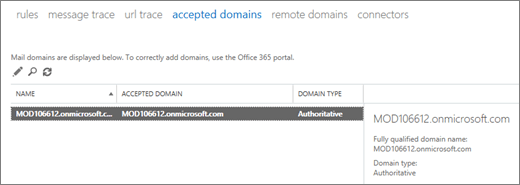
-
Double-click the domain name.
-
In the Accepted Domain dialog box, set the domain to Internal Relay, and then select Save.
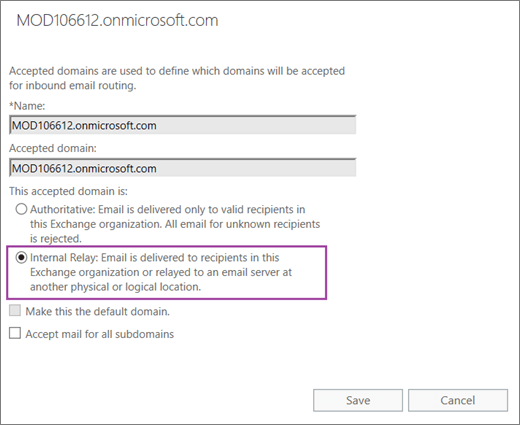
Manually synchronize on-premises and Office 365 directories
If you have a hybrid configuration and the recipient is located on-premises, it's possible the recipient's on-premises email address isn't properly synchronized with Office 365. Follow these steps to synchronize directories manually:
-
Log into your on-premises DIRSYNC server (the server running the Directory Synchronization Tools).
-
Start a Windows PowerShell session.
-
Go to: C:\Program Files\Microsoft Online Directory Sync.
-
Run the command DirSyncConfigShell.psc1 to start the Directory Synchronization Configuration Shell.
-
Run the command Start-OnlineCoexistenceSync.
When synchronization completes, repeat the steps in Verify that the recipient exists and has an active license assigned to verify that the recipient address exists in Office 365.
Verify domain's mail exchanger (MX) record
If you have a custom domain (like contoso.com instead of contoso.onmicrosoft.com), it's possible your domain's MX record isn't configured correctly.
-
In the Office 365 Admin center, go to Settings > Domains, and then select the recipient's domain.
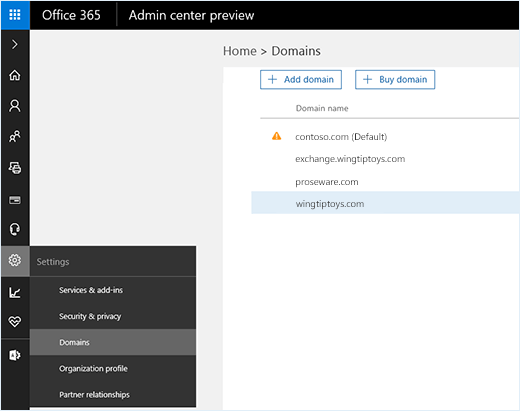
-
In the pop-out Required DNS settings pane, select Check DNS.
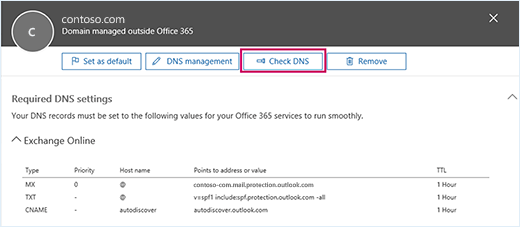
-
Verify that there is only one MX record configured for the recipient's domain. Microsoft doesn't support using more than one MX record for a domain that's enrolled in Office 365.
-
If Office 365 detects any issues with your Exchange Online DNS record settings, follow the recommended steps to fix them. You may be prompted to make the changes directly within the Office 365 admin center. Otherwise, you must update the MX record from your DNS host provider's portal. For more information, see Create DNS records for Office 365 at any DNS hosting provider.
Note: For most scenarios, your domain's MX record should point to the Office 365 fully qualified domain name: <your domain>.mail.protection.outlook.com. DNS record updates usually propagate across the Internet in a few hours, but they can take up to 72 hours.
For more information
Email non-delivery reports in Office 365
Configure email forwarding for a mailbox
Synchronizing your directory with Office 365 is easy
Create DNS records at any DNS hosting provider for Office 365
Still need help with a 5.1.10 bounce message?



No comments:
Post a Comment